#exsitu
Explore tagged Tumblr posts
Text
Remember we are always finding new things, rediscovery is discovery, never feel bored looking the same habitat over again and again, it’s possible to miss something.
Localized extirpation, full extinction, extinction in the wild, and potential rediscovery and discovery... Shorts goldenrod redescovered juxtaposed with Ohio River Scurfpea, Kankakee globe flower rediscovered in two populations that both were caused by accidental fire, Utah astragalis growing in a small pit of desert rediscovered after developement abandoned, genetic work to re-invigorate Franklandia tree and Kentucky clover being done by Smithsonian and CREW.
We can look at potential future extinctions and try to preserve what may be inevitable through exsitu conservation. Paxistima canbyi is a plant I want to study before this happens. It would be nice to try to preserve it.
https://www.wbur.org/hereandnow/2020/08/20/save-rare-plant-species-extinction
We here a lot of stories about rediscovery and preservation, genetic modification, and even just plain discovery and it never stops amazing me.
Chestnut trees are being modified by a single gene from one species in poaceae and are almost back on the market.
We forget that Ginkgo was thought to be extinct in the wild in previous history only preserved along temples and royal palace roadways until rediscovery.
i’ve been still talking about ragweed thickets and specifically riparian broom rape and forms of local ecosystem adaptation.
just got off of a pleasant instagram call with my friend Bonnie talking about ecotones and talking about thicket forbes and grasses and how much leaf litter can be produced and species that co evolve to parasitize or become mycoheterotrophic species; With the idea of riparian broom rape we can talk about the potential of what has been lost from development and what had no chance to be studied.
No one studies canebrakes, no one looks deep in them; but they are full of mice and canebrake rattlesnakes, snake diversity in general, and probably had unique beetles and millipedes that were adapted to them. We don’t have many river side canebrakes left and might really only have canebrakes that are inland to the extent we need. There is always potential to find unique fungus and plants that coevolved in these habitats too.
One thing led to another and we started talking about one plant that I had never heard of and was sent a small blog blerb from someone who used to post on here a lot in the later days in between his masters and starting his PHD. Also check out his podcasts and youtube channel too if you can.
@indefenseofplants Matt made a post about a wet prairie species that went unnoticed, then noticed, and became a transient memory in a few herbariums in a brief amount of time. He talks briefly about what is known of original site history, and gives a bit of note to the possibility of sites still having it; just it not being seen.
Probably one of the coolest plants that I wish we could rediscover:
https://www.indefenseofplants.com/blog/2015/3/12/an-extinction-in-chicago
15 notes
·
View notes
Text
Soil Remediation
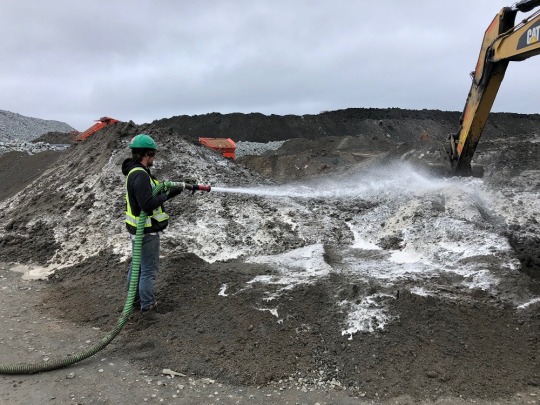
Soil remediation is a phrase that refers to different procedures designed to remove contaminants such as hydrocarbons, heavy metals, pesticides, cyanides, volatiles, creosote, and semi-volatiles from dirt. Soil remediation is required to clean and maintain top quality criteria of dirt, water, and air that may consequently advantage commercial cultivation, and wild flora and fauna.
Soil Remediation- Types of Approaches:
There are four main forms of soil remediation methods for the removal of pollutants and contamination from soils which have accumulated enough documentation to provide them prominence being used.
These methods include:
Bioremediation: Bioremediation involves the treatment of contaminated lands by biological means.
The process uses bacterium, particularly targeted to absorb and break down hydrocarbons together with other pollutants from land. The Benefit of the procedure also lies in the fact that whenever contamination is consumed all the germs die off.
Nevertheless, notice that the procedure is more successful in dirt that preserves 70 degrees F of temperature with irregular rain for optimal moisture. And for bioremediation to be efficient in colder climates, soils must be suitably covered and insulated.
It’s since the colder the ambient weather will be, the longer the reclamation time the process will take. Popular Bioremediation Services Company Suppliers – Solutions, Delta Remediation Inc.
Thermal Soil Remediation: This method includes heating contaminated material in this PTU to evaporate hydrocarbon impurities and water.
Here, polluted materials are often treated at temperatures of 650 F to 900 F, and after that Discharged from the PTU to a cooling unit, which is a mixer, or auger where water is added to get cooling and dust control.
The treated material is then discharged from this cooling unit through a conveying system, ready to get testing, and subsequent recycling.
The actual time the procedure takes in treatment depends upon different factors like the depth of this hydrocarbon pollution, the concentration level of contaminating, the pH factor of this dirt, and the permeability of the dirt.
Encapsulation: The process of encapsulation doesn’t filter contaminants from dirt so much as it separates them. This could be done in lots of ways, but probably the most typical way includes mixing the contaminated dirt with lime, cement, and concrete, leading to preventing the contaminants from spreading to wash soil.
Originally published at https://deltaremediation.com
#Deltaremediation#BioLogix#screenlogix#hydrocarbonscreening#soilsampling#spillresponse#spillcontainment#spillcontrol#bioaugmentation#bioremediation#naturallyamplified#remediation#environment#environmental#reclamation#albertaenergy#canadianenergy#insitu#exsitu#hydrocarbons
2 notes
·
View notes
Photo

Save more endangered plants—support the Garden! 🌴 In July, the Garden’s Andean Wax Palms (Ceroxylon quindiuense) flowered for the first time ever in our Andean Cloud Forest collection. Experts believe this is the first Ceroxylon quindiuense to flower in North America. 🌴 The Andean Wax Palm is endangered, and San Francisco Botanical Garden is one of just five gardens worldwide (outside of Latin America) to house a collection of them. Our special foggy climate allows unique plants to flourish and your support enables us to continue our efforts to save and propagate rare, vulnerable, and endangered plants. 🌴 Donate Today! Link in profile. 🌴 #sfbotanicalgarden #saveplants #ceroxylonquindiuense #andeanwaxpalm #waxpalms #andeancloudforest #andes #andesmountains #endangeredspecies #exsitu (at San Francisco Botanical Garden) https://www.instagram.com/p/B6OXWvSgmj-/?igshid=1mesd3ds2t0i8
#sfbotanicalgarden#saveplants#ceroxylonquindiuense#andeanwaxpalm#waxpalms#andeancloudforest#andes#andesmountains#endangeredspecies#exsitu
1 note
·
View note
Text
Landrace and Heirloom Varieties Critically Endangered and Threatened Cannabis Genetic Resources
'Today distinct cannabis landraces are the most at risk cannabis populations. The introduction of foreign gene pools (particularly modern hybrids) into traditional cultivation regions and centers of diversity threatens the genetically distinct diverse populations in these regions (Wiegand, 1935, Rhymer and Simberloff 1996, Merlin and Clarke 2013).
In 2020 John McPartland and Ernest Small and John co-authored a paper describing landrace populations of cannabis in south and central Asia as critically endangered and in need of immediate conservation action warning “[w]orldwide introgressive hybridization…threatens the agro-biodiversity of C. sativa.” Specifically, “Central and South Asian landraces face extinction through introgressive hybridization.” They argue, “…formal recognition of indigenous Central and South Asian varieties…may help prevent their extinction.” Concluding, “collection and conservation of germplasm of indigenous populations of Central and South Asian landraces in their centers of diversity is urgently needed.” The findings of McPartland and Small echo a common concern emerging in the literature on cannabis genetic resources (Clarke and Merlin 2013, Welling 2016).
Existing heirloom cannabis varieties are also important sources of genetic diversity critically threatened by genetic erosion. We have already witnessed the disappearance of specific traits and varieties that were once ubiquitous though are no longer readily available driven largely by the forces described above in the section on prohibition. Going forward if decisions regarding genetic resources of heirloom and landrace cannabis varieties are left in the hands of government regulators and licensed commercial farms, as market forces and consumer trends increasingly determine what is or is not commercially viable within the regulated markets heirloom and landrace varieties will be increasingly subject to the whims of the market with all of the attendant consequences.
Today, all around the world, cannabis genetic resources are critically endangered. Instead of acknowledging the inherent value of cannabis genetic resources and the threat of genetic erosion policy makers, bureaucrats, law enforcement officials and commercial interests have actively adopted policies and practices that exacerbate the problem and contribute to genetic erosion. In the absence of coherent coordinated international efforts to protect and preserve cannabis genetic resources the urgency of the present moment calls for those of us in the grassroots cannabis movement to organize around concrete strategies to preserve cannabis genetic resources. This column will provide a space for exploring and mobilizing around these concrete strategies to preserve and improve cannabis genetic resources into the future.' - @sungrownmidz Source: https://skunkmagazine.com/cannabis-genetic-resources-the-seeds-of-our-collective-past-present-and-future/
1 note
·
View note
Photo

This is a particularly beautiful species of centrolenid - the Granular Glass Frog, Cochranella granulosa. Follow @amphibianfoundation for more beautiful pictures and information on Amphibians, amphibian conservation and declines. Glass frogs are transparent on their ventral surface, but their dorsal coloration can be quite beautiful. C. granulosa often has shades of blue mixed with green on their dorsum. Their granular glands are also quite prominent and spectacular! #Cochranella #Cochranellagranulosa #GranularGlassFrog #Centrolenidae #AmphibianConservation #AmphibianConservationProgram #FrogsNeedOurHelp #EndangeredSpecies #RacingExtinction #EndExtinction #FrogsOfInstagram #frogs #frog #ribbit #CaptiveBreeding #CaptiveBred #ExSitu #InSitu #CaptiveAssuranceColony #CaptiveBreedingColony #Mandica #CritterCamp #Critter-Camp #AmphibianFoundation #TheAmphibianFoundation (at The Amphibian Foundation, Inc)
#granularglassfrog#critter#insitu#cochranella#captivebred#amphibianconservationprogram#racingextinction#frogsneedourhelp#captivebreedingcolony#mandica#exsitu#endangeredspecies#captiveassurancecolony#frogs#frogsofinstagram#frog#theamphibianfoundation#captivebreeding#centrolenidae#amphibianconservation#crittercamp#cochranellagranulosa#amphibianfoundation#ribbit#endextinction
6 notes
·
View notes
Video
Cleaning is really important in the #bristolaggienrm turtle head-starting lab. Aquatic turtles can be really messy and poor water quality can lead to health issues. Head-starting is not helpful if we release sick animals. After these filters pads are mechanically cleaned with the hose they go into the sanitizing bath for at least five minutes. Biosecurity is extremely important for any ex situ conservation work that will release animals into wild populations. #turtles #aquatic #waterquality #animals #wild #population #cleaning #sanitize #mystudentrock #exsitu #conservation #biosecurity @bristolaggie (at Bristol County Agricultural High) https://www.instagram.com/p/BssZaRmHTR5/?utm_source=ig_tumblr_share&igshid=1cq06v1zp3eun
#bristolaggienrm#turtles#aquatic#waterquality#animals#wild#population#cleaning#sanitize#mystudentrock#exsitu#conservation#biosecurity
0 notes
Text
Bio-Boosted Decomposition of Wastes for Discouraging Biomass Burning for Clean Air and Prospering Agriculture - Crimson Publishers

Bio-Boosted Decomposition of Wastes for Discouraging Biomass Burning for Clean Air and Prospering Agriculture by Yadav RC in Significances of Bioengineering & Biosciences: Crimson Publishers- Journal of Bioscience and Bioengineering
Ecology is science dealing balance in entities both alive and non-alive existing in any environment. Mahatma Gandhi’s eye lenses are adopted as emblem of new vision for mission sanitation in India. However, there had been merely action of sweeping trashes and collecting at sites, which again reverts back as becoming garbage dumping sites and disposing wastes including pet’s droppings. Such garbage wastes easily burned for their disposal. Hence, the mission sanitation did not make any difference between the present and the past scenarios of sanitation and betterment of ecology. Various previous measures for waste utilization provoked towards discouragement for biomass burning, had been attempting without any scientific backing. Objective of present study was to develop a scientific fact application based method of decomposition of such wastes including agriculture wastes, highly liable to insitu or exsitu burning, leading to cause air pollution. A combo of bio decomposer boosted sulphur cycle supporting decomposing and aerobic composting of biomass, established in past, was carved as new route of overcoming the biomass burning for maintaining clean air. The measure also supports utilization of solid Municipal wastes. Thus, organic manure producing innovative method becomes an engine for bringing complete sanitation and many improvements in agriculture and environment. This research with double bio innovation becomes intellectual property for managing bio-wastes as well as bringing complete sanitation in improving ecology and clean air, thereby building double benefits i.e., becoming a solution of the problem and producing beneficial useful products.
https://crimsonpublishers.com/sbb/fulltext/SBB.000598.php
For more Open access journals in Crimson Publishers please click on the link: https://crimsonpublishers.com/indexing-archiving-list.php
For more articles in Significances of Bioengineering & Biosciences, please click on below link: https://crimsonpublishers.com/sbb/
0 notes
Text
Biyoremediasyon ve Biyodegrasyon: Kısaca Bütün Temizlik İşlerini Bakterilere Yaptırmak
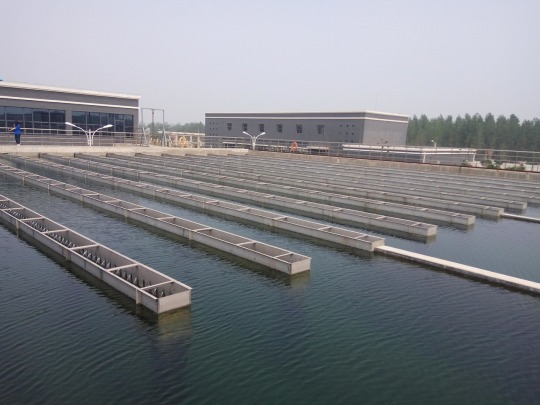
Biyoremediasyon; mikroorganizmaların kirleticileri bünyelerine alma kapasitesine sahip olmaları, bunları büyüme ve metabolik faaliyetleri için kullanmaları esasına dayanmaktadır. Biyoremediasyon tasarımının asıl amacı, mikrobiyal büyüme ve aktivite için en uygun şartların sağlanmasıdır. Her geçen gün çevremiz hızla kirlenmeye devam ediyor. Bunu elbette biz insanlar yapıyoruz. Yeni fabrikalar; yeni çalışma alanları, yeni teknolojik ürünlerin üretilmesi, hayatımızın kolaylaştırılması demektir. Fakat fabrika atıkları, suları, topraklarımızı ve dahi yaşam alanlarımızı kirletiyor. Şöyle bir durup etrafımıza baktığımızda yaşam alanlarımızın konforunu artırırken yaşam alanımızı kirleterek daraltmaya devam ettiğimizi fark ediyoruz. Daha sonra meydana getirdiğimiz pislikleri temizleme çabasına giriyoruz. Girdiğimiz bu çabalar bir miktar temizliği sağlasa da kullanılan kimyasallar toprağa, suya zarar veriyor. Bu zararı en aza indirmek için neler yapılabilir diye düşünülmüş. Araştırmacılar bu kirlilik sorununu bakterilerle halledebilir miyiz diye düşünmüşler ve temizlik olayında bakterileri kullanmaya başlamışlar. Bunun da biyoremediasyon ve biyodegrasyon isimlerini vermişler. Biyoremediasyonu bilimsel dille değil de kendi günlük kullandığımız dille açıklayacak olursak; bir nevi evrenimizin temizlik işçileri diyebiliriz. Bakteriler bizim için kirlilik sebebi olan maddeleri kendi bünyelerine alıp onları kendi meztabolizma aktiviteleri için kullanıyorlar. Yani kısacası onları yiyorlar diyebiliriz.
Nasıl oluyor peki bu olaylar?
Gelin bir göz atalım J Biyoremediasyon iki biçimde uygulanır. İn-situ (yerinde yapılan) ve Ex-situ (yerinde yapılmayan) şeklinde. İn-situ (yerinde yapılan): Atıkların döküldüğü bölgeye besin (nutrient) aktarımı yapılarak, toprağın bakteri kompozisyonuna göre, hali hazırda toprakta bulunan bakteriler etkin duruma geçirilir (Yerinde (in-situ) bertaraf teknolojileri). Bu yöntem kirletici konsantrasyonlarının düşük olması durumunda kullanılır. Ex-situ (yerinde yapılmayan): Toprak kazılarak yerinden alınır ve kirletici parçalama yeteneğine sahip yeni bakteriler ilave edilir. Çevresel koşullar kontrol edilir veya mikroorganizmaların metabolik aktivitelerini ve büyümelerini optimize etmek için koşullar değiştirilir. Biyoremediasyon için çevresel şartların optimizasyonunda; sıcaklık, inorganik nutrientler (öncelikle azot ve fosfor), elektron alıcılar (oksijen, nitrat ve sülfat) ve pH gibi faktörler uygun hale getirilir (Yerinde yapılmayan (ex-situ) bertaraf teknolojileri). Yerinde Yapılmayan (ex-situ) Biyoremediasyon Metotları Bu yöntem toprağın doğal ortamından kazılarak alınmasını gerektirir. Bunun amacı mikrobiyal parçalamayı kolaylaştırmaktır. Kirlenmiş sahadan uzakta gerçekleştirilen ex-situ biyoremediasyon metotları, yerinde yapılan (in-situ) metotlara göre daha hızlıdır. Geniş alana yayılmış kirleticiler için uygulanabilir fakat daha pahalı bir yöntemdir. Wolicka ve diğ., (2009) yaptıkları çalışmada laboratuar şartlarında aerobik kültürler tarafından petrol türevleri olan benzen için %84, toluen için %86, etil benzen için %80 ve ksilen için %82 oranında giderim tespit etmişlerdir. Guerin (2008) yaptığı çalışmada topraktaki klorobenzenlerin biyoremediasyonunda ex-situ yöntemlerle 2-3 haftalık periyotta %90 oranında giderim sağlandığını belirtmiştir. Bunun yanı sıra, hidrokarbonların topraktan uzaklaştırılmasında ex-situ teknikler başarılı olarak kullanılmaktadır. Islahın özel tanklarda ya da hazır zeminlerde gerçekleştirilip gerçekleştirilmediğine göre exsitu biyoremediasyon iki teknolojiyi kapsar.
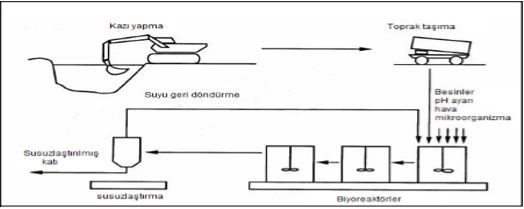
Sulu Faz İşlemi (Biyoreaktörler) Biyoreaktörler ex-situ tekniğinin en önemli çeşididir (Şekil 3). Dayanıklı ve toksik kirleticilerle kirlenmiş toprakların biyoremediasyon ile ıslahında en iyi seçenek çevre şartlarının kontrol altında alınabildiği biyoreaktör tekniğidir (Şekil 4). Kirleticilerin giderim oranı sistemdeki aktif mikroorganizmaların parçalama kabiliyetlerine bağlıdır. Bu reaktörler kesikli, yarı-sürekli ve sürekli olmak üzere sınıflandırılırlar. Genel olarak kesikli reaktörler tercih edilmektedir. Bunun yanı sıra elektron alıcısına bağlı olarak da aerobik (moleküler oksijen), anoksik ( nitrat ve bazı metal katyonlar), anaerobik (sülfat, metanojenik, fermentasyon) ve karışık elektron alıcıların kullanıldığı sistemler bulunmaktadır.
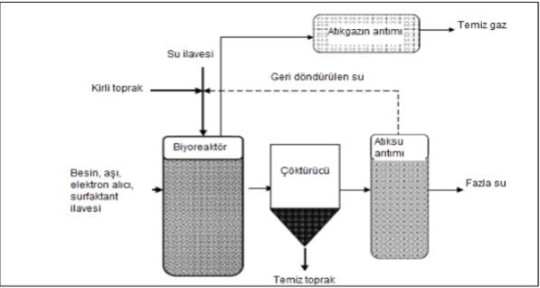
Sulu fazlı biyoremediasyon arıtım uygulaması diğer arıtım yöntemleriyle karşılaştırıldığında çok daha hızlı bir yöntemdir. Topraktaki kirleticiler ile temas halinde olan ve toprakta zaten doğal olarak bulunan mikroorganizmaları tutmak için bu teknolojide kirlenmiş toprak yerinden kazılarak özel vasıtalarla alınır ve özel tanklarda su ile karıştırılır. Oksijen ve besinler daha sonra eklenir. Kirleticilerin parçalanmasında organizmaların biyoaktivitelerini devam ettirmek ve en iyi koşulları sağlamak için ısı, besin ve oksijen konsantrasyonları kontrol edilir. Bu yöntemin kütle transfer oranının ve mikroorganizma/kirletici/nutrient oranlarının arttırılabilmesi, farklı elektron alıcıların kullanılabilmesi, surfaktan ve solvent kullanımı ile kirleticinin parçalanmasının artırılması, çevresel şartların optimizasyon ve kontrolünün sağlanması gibi avantajları bulunmaktadır. Gonzales ve diğ., (2008) yaptıkları araştırmada biyoreaktörlerin hidrokarbonlar ve bazı organoklorlu maddeler gibi toksik ve parçalanmaya dirençli maddelerle kirlenmiş toprakların ıslahında etkili bir ex-situ yöntem olarak değerlendirilebileceğini belirtmişlerdir. Piren ile kirlenmiş toprakların anoksik-aerobik-anoksik-anoksik şartlarda kesikli biyoreaktörlerde ıslahının mümkün olduğu belirtilmiştir. Bu çalışmada bekleme süresi 120 saat, yükleme oranı 20 kg/m3, sıcaklık 28±2°C olarak seçilerek 6 farklı reaktör çeşitli substrat konsantrasyonlarında çalıştırılmıştır. Reaktörlerden bazılarına parçalanmayı biyolojik olarak güçlendirmek için evsel çamur aşılaması yapılmıştır. Sonuçlar, evsel çamur ilavesi ile biyolojik güçlendirme yapılan reaktörlerde parçalanmanın çamur ilavesi yapılmayanlara oranla daha yüksek olduğunu göstermektedir. Diğer önemli bir kirletici olan PAH’ların (poliaromatik hidrokarbon) aerobik ve anaerobik işletilen biyoreaktörlerde giderilebildiği yapılan çalışmalarla ortaya konmuştur. Metabolik fonksiyonlar (aerobik, anaerobik, anoksik), tek veya karışık mikroçevre şartları, doğal karışık mikroflora ve aşılama şartlarının biyoreaktörlerde sağlanması ve kontrolü ile PAH’ların parçalanması sağlanabilmektedir. PAH’ların toksik ve hidrofobik kirleticiler olması, toprak kompozisyonu, heterojen mikrobiyal çevre şartları biyoremediasyonu kompleks hale getirebilmektedir. Larsen ve diğ., (2009) yaptıkları çalışmada arıtma çamurundaki PAH’ların giderilmesinde ex-situ biyoremediasyon tekniği olan biyoreaktörlerin kullanılabileceğini göstermişlerdir. Biyolojik parçalanmanın hızlanması için Proteiniphilum acetatigenes kullanılarak biotik ve abiotik şartlarda %80’e varan parçalanma meydana geldiğini bulmuşlardır. Kısacası bakterilerle temizlik yapmak çok kolay. Kaynaklar Adeniyi, A. A., Afolabi, J.A. (2002) Determination of total petroleum hydrocarbons and heavy metals in soils within the vicinity of facilities handling refined petroleum products in lagos metropolis. Environmental International, 28, 79-82 Baker, K.H, Herson, D.S. (1994). Bioremediation. McGraw – Hill, New York Read the full article
0 notes
Video
youtube
KYWEBINAR
>KY plant communities
>Insitu vs. exsitu conservation
>types of exsitu conservation
>why you grab all seeds instead of select to preserve natural genetic vigor
>Orchid Project!
> what else is collected, fungi?, Genetic data?
>who partners with these projects.
>Roadside PROJ.
>target communities not just rare plants.
>local ecotypes should be preferred with mostly local seed and few introduced genetics if planning an ex-situ project.
>what Ky plant communities are targeted
14 notes
·
View notes
Text
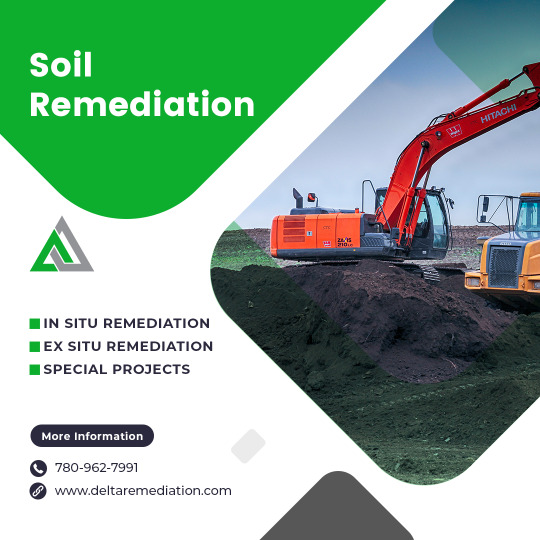
We come to sites and leave it cleaner than we found it; not only do we clean up the soil but we go above and beyond our work to remove all the garbage both soil and underground.
Although remediation specializes in cleaning only the contaminated soil, our team takes pride in leaving the environment cleaner than we found it. Not only do we clean the earth, we go above and beyond our work to remove all the garbage both in the soil and underground, leaving job sites looking better than when we arrived.
We take pride in our work and our customer reviews validate this!
#BioLogix#bioaugmentation#bioremediation#naturallyamplified#remediation#environment#environmental#reclamation#albertaenergy#canadianenergy#insitu#exsitu#hydrocarbons
1 note
·
View note
Photo

Another species we have the privilege of working with and breeding at the @AmphibianFoundation, is the Blue-side Leaf Frog — Agalychnis annae. A spectacular #phyllomedusine (or Leaf Frog), this frog is a #CriticallyEndangered species with populations still declining in the wild. I got particularly lucky with this shot, as this species rarely stays still. This species clearly bears a resemblance to its cousin, the Red-eyed Leaf Frog (Agalychnis callidryas) but it’s not nearly as easy to breed A. annae in captivity. In the wild, these two Central American species are #sympatric but as A. annae continues to decline, the species are moving toward #allopatry. #Agalychnis #Agalychnisannae #YellowEyedLeafFrog #BlueSidedLeafFrog #Phyllomedusinae #Hylidae #TreeFrog #LeafFrog #AmphibianConservation #AmphibianConservationProgram #FrogsNeedOurHelp #EndangeredSpecies #RacingExtinction #EndExtinction #FrogsOfInstagram #frogs #frog #ribbit #CaptiveBreeding #CaptiveBred #ExSitu #InSitu #CaptiveAssuranceColony #CaptiveBreedingColony #Mandica #CritterCamp #Critter-Camp #AmphibianFoundation #TheAmphibianFoundation
#theamphibianfoundation#endangeredspecies#captivebreedingcolony#critter#insitu#amphibianconservationprogram#frogsneedourhelp#treefrog#exsitu#crittercamp#frogsofinstagram#sympatric#agalychnis#racingextinction#amphibianfoundation#phyllomedusine#bluesidedleaffrog#mandica#criticallyendangered#allopatry#frogs#hylidae#leaffrog#amphibianconservation#frog#captiveassurancecolony#endextinction#captivebreeding#yelloweyedleaffrog#agalychnisannae
7 notes
·
View notes
Text
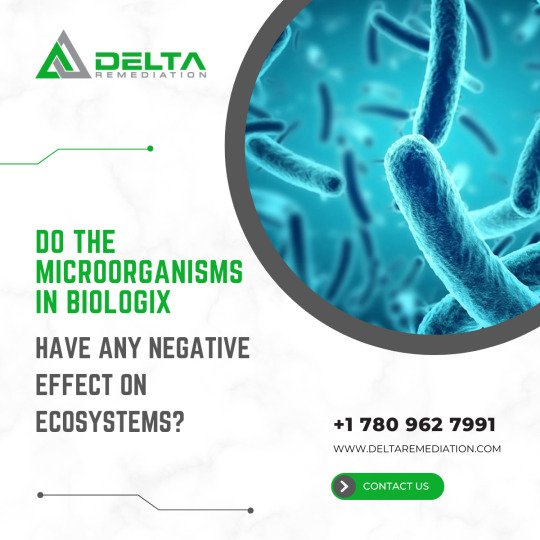
DO THE MICROORGANISMS IN BIOLOGIX HAVE ANY NEGATIVE EFFECT ON ECOSYSTEMS?
▶️ Delta uses specific strains of microbes that have an affinity for hydrocarbons. Once the hydrocarbon energy source is consumed, the introduced microbes die off until the site returns to its natural state. There is absolutely no negative effect to plants, animals, or the environment.
🤝 Contact us: 10436 255 St Acheson, AB T7X 6B4 Canada
📞 +1 780-962-7991 ✉️ [email protected] 🌐 https://deltaremediation.com
Linkedin: https://www.linkedin.com/company/delta-remediation-inc/ Facebook: https://www.facebook.com/deltaremediation/ Twitter: https://twitter.com/DeltaRemediate Pinterest: https://www.pinterest.ca/arahman0756/ Instagram: https://www.instagram.com/deltaremediation/
#Deltaremediation#BioLogix#screenlogix#hydrocarbonscreening#soilsampling#spillresponse#spillcontainment#spillcontrol#bioaugmentation#bioremediation#naturallyamplified#remediation#environment#environmental#reclamation#albertaenergy#canadianenergy#insitu#exsitu#hydrocarbons#SoilRemediation#BioremediationCanada#GroundwaterRemediation
0 notes
Text
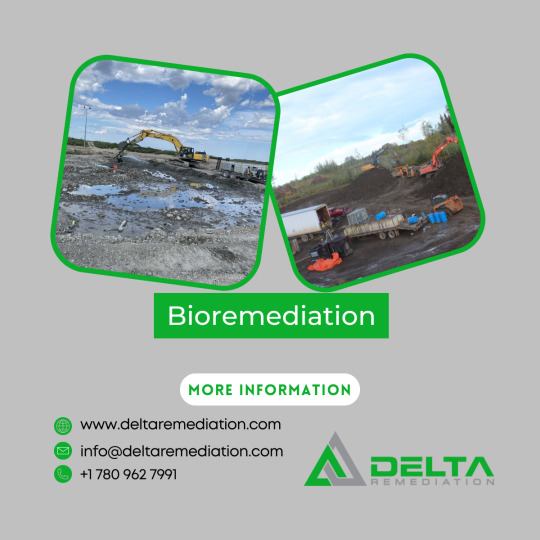
HOW ARE BIOREMEDIATION APPLICATIONS COMPLETED?
▶️ Bioremediation applications can vary greatly from simply spraying a surface spill to much more specialized treatment systems. Treatment systems or methods all fall into one of 2 categories In Situ and Ex Situ. ▶️ In both In-Situ (treated in place) and Ex-Situ (excavated and treated above ground) applications of its microbial products are coupled with dynamic surfactants and other beneficial amendments when required.
🤝 Contact us: 10436 255 St Acheson, AB T7X 6B4 Canada
📞 +1 780-962-7991 ✉️ [email protected] 🌐 https://deltaremediation.com
Linkedin: https://www.linkedin.com/company/delta-remediation-inc/ Facebook: https://www.facebook.com/deltaremediation/ Twitter: https://twitter.com/DeltaRemediate Pinterest: https://www.pinterest.ca/arahman0756/ Instagram: https://www.instagram.com/deltaremediation/
#Deltaremediation#BioLogix#screenlogix#hydrocarbonscreening#soilsampling#spillresponse#spillcontainment#spillcontrol#bioaugmentation#bioremediation#naturallyamplified#remediation#environment#environmental#reclamation#albertaenergy#canadianenergy#insitu#exsitu#hydrocarbons#SoilRemediation#SoilRemediationMethods#BioremediationCanada#GroundwaterRemediation
0 notes
Text

What is Delta Remediation's Service Area?
💧 Based in Edmonton Alberta, Delta Remediation is strategically located to support both Alberta and Northern BC Oil and Gas industries. 🔸 Having successfully completed work in ALL Western Provinces, Delta is able to provide its specialized equipment and manpower for industrial remediation projects across Western Canada. 🔹 For projects outside of Western Canada, Delta typically works with local contractors to keep projects cost-effective.
🤝 Contact us: 10436 255 St Acheson, AB T7X 6B4 Canada
📞 +1 780-962-7991 ✉️ [email protected] 🌐 https://deltaremediation.com
Linkedin: https://www.linkedin.com/company/delta-remediation-inc/ Facebook: https://www.facebook.com/deltaremediation/ Twitter: https://twitter.com/DeltaRemediate Pinterest: https://www.pinterest.ca/arahman0756/ Instagram: https://www.instagram.com/deltaremediation/
#Deltaremediation#BioLogix#screenlogix#hydrocarbonscreening#soilsampling#spillresponse#spillcontainment#spillcontrol#bioaugmentation#bioremediation#naturallyamplified#remediation#environment#environmental#reclamation#albertaenergy#canadianenergy#insitu#exsitu#hydrocarbons#SoilRemediation#SoilRemediationMethods#BioremediationCanada#GroundwaterRemediation
0 notes
Text

♻️ Bioaugmentation is a bioremediation process that relies on introducing specific strains of bacteria to remediate the contaminants in soils or water.
▶️ In bioaugmentation, practitioners augment native microbial populations by introducing specific species into the microbial ecosystem.
🤝 Contact us: 10436 255 St Acheson, AB T7X 6B4 Canada
📞 +1 780-962-7991 ✉️ [email protected] 🌐 https://deltaremediation.com
Linkedin: https://www.linkedin.com/company/delta-remediation-inc/ Facebook: https://www.facebook.com/deltaremediation/ Twitter: https://twitter.com/DeltaRemediate Pinterest: https://www.pinterest.ca/arahman0756/ Instagram: https://www.instagram.com/deltaremediation/
#Deltaremediation#BioLogix#screenlogix#hydrocarbonscreening#soilsampling#spillresponse#spillcontainment#spillcontrol#bioaugmentation#bioremediation#naturallyamplified#remediation#environment#environmental#reclamation#albertaenergy#canadianenergy#insitu#exsitu#hydrocarbons#SoilRemediation#SoilRemediationMethods#BioremediationCanada#GroundwaterRemediation
0 notes
